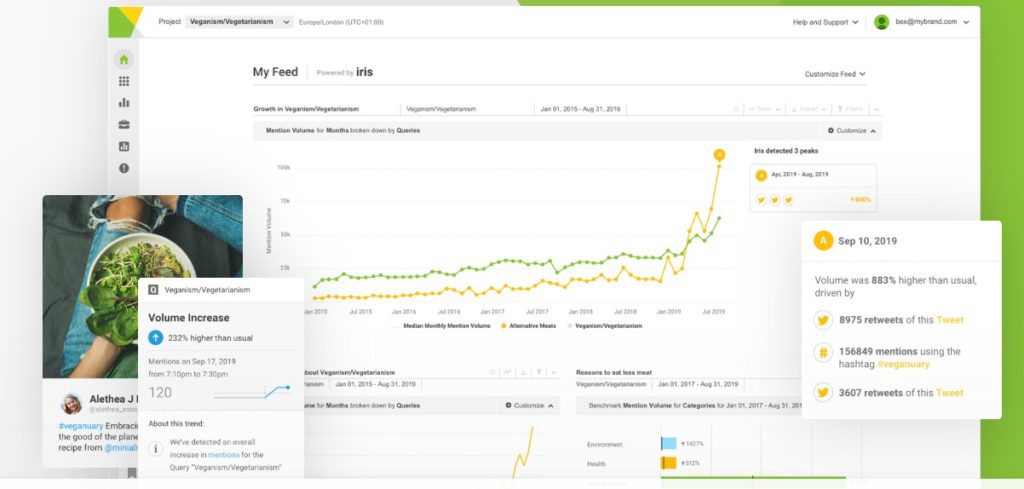Social media management is crucial to brand building, whether that’s handling negative reviews or creating a positive brand image.
The value of your brand’s reputation is irreplaceable, and you should protect it at all means. When it comes to brand building, you need to be aware of all the reviews your customers publish online and be ready to respond to customer’s complaints 24/7. Combing through the key aspects of social media reputation management, these handy tips will help you get rid of negative reviews and create a positive brand image.
What is Social Media Reputation Management?
Before we dive into the topic, let’s clarify what social media reputation management is all about.
Social media reputation management is a complex process that includes:
• Tracking customer reviews and brand mentions
• Handling and preventing negative comments
• Cultivating positive attitudes toward the brand
“To manage reputation on social media means to minimise the number of negative reviews as well as the damage they bring and to boost positive review generation to improve one’s name or standing,” explains Merlin Watson, a brand manager at Studicus.
6 Tips to Manage Your Social Media Reputation
Use Social Listening Tools to Monitor Brand Mentions
Social listening is a crucial brand building process that consists of two parts. The first part is about monitoring social media for customer feedback, direct brand mentions, and discussions of relatable keywords and topics. The second part is about data analysis and actionable responses.
What’s obvious is that you can’t carry out social listening manually. You’ll need the help of social listening tools like Brandwatch, Hootsuite, and Brand24. They work effectively, allowing you to monitor user-generated content, spot changes in sentiment, and track fluctuations in brand health.
Here are a few tips on how to choose the right social media listening tool:
• Analyse your needs and your budget.
If you run a small company and don’t have an in-house digital marketer, don’t overpay for pricey tools designed for advanced marketers.
• Check the availability of various visualisation tools.
Good visualisations will help you to analyse collected data faster and more effectively.
• Check out how the tool’s dashboards look like.
Make sure that your chosen platform has a user-friendly interface.

Source: brandwatch.com
Reply to Negative Comments Immediately
Well, no one loves to get mean tweets and negative reviews. But it’s inevitable. No matter how well your company is performing, there will always be a person who writes something bad about your product or service.
The rule of thumb for dealing with negative comments is to never ignore negative comments and to always respond promptly. Here are a few handy tips on how to successfully manage negativity on social media:
• Acknowledge the problem and apologise for the inconvenience.
In the case that the customer’s problem is not your company’s fault, reply with, “We’re sorry to hear about your experience.”
• Be polite. Always.
Even when you are replying to poorly written or nonsensical comments.
• Delete offensive and vulgar comments.
Remove comments that insult your brand, your employees, or your customers, provoking further escalation of the negative situation.
• Try to manage conflict with humour.
Sometimes a clever joke can save the situation.
• Never argue with the clients in the comments.
Find a way to take the conversation out of social media. Ask the unsatisfied customer to write you a direct message or contact your customer support team.

Source: IG: @urbanoutfitters
Learn a Lesson from the Negative Reviews
Negative reviews are not a death sentence for your brand. In fact, if you pay close attention to what customers write in their negative reviews, you can improve your product, create more relevant content for social media, and take your business’s brand building to the next level.
Let’s say you sell a highly-effective hair growth shampoo. You have just received 20 reviews from people complaining that your shampoo doesn’t, in fact, help to regrow hair. You analysed the reviews and figured out that your customers did not use your product as directed, resulting in a low level of satisfaction.
What should you do next to fix the situation? You could create more educational and how-to content for social media. If you teach shoppers to use your products the right way, the level of satisfaction will rise, and the number of negative reviews will drop.
Encourage Customers to Share Positive Reviews
If you want to improve your reputation with social media, you should do your best to generate a bunch of new positive reviews.
The thing that customers pay attention to is the ratio of positive and negative reviews. If you have received 3 bad comments and only 2 good ones, that’s a failure. But if you have received 3 negative comments and 100 positive ones, it means your brand’s reputation is almost perfect.
To get more positive reviews, you should do the following:
• Encourage customers to use your branded tag and hashtag.

Source: IG: @forever21
• Leverage email marketing.
Offer a discount on the next order in exchange for a positive review.
• Create high-quality content to engage your audience.
Get professional assistance from content creators and writers, if necessary. Consider using writing websites such as TrustMyPaper and WowGrade or freelance platforms like Upwork.
• Thank your customers for every post, mention, and positive comment that they share.
Show your customers that you appreciate their loyalty.
Repost and Retweet Positive Reviews
Once your customers have published positive reviews, you can take the next step – share user-generated content on your feed. You should do it by following a few simple rules:
• Always ask your customers for permission to share their posts.
• Choose one filter to apply to all user-generated posts. It will help you to create a cohesive profile aesthetic.
• If your customers generate tons of content, group several posts together. For instance, use 10 user-generated posts to create one Instagram carousel post.

Source: Tw: @DiGiorno
Strive to Maintain a Perfect Praise-Criticism Ratio
Let’s clarify one important thing. Negative reviews are not necessarily a bad thing. According to Reevoo, 95% of consumers suspect fake or censored reviews when negative reviews aren’t found on the web.
What do these statistics mean to you? It means that you should not strive to get 0 positive reviews and 100 five-star reviews. Instead, your goal should be to generate honest, real-customer reviews that mainly mention the advantages of your product, but also include some insignificant disadvantages.
The experts say that the perfect praise-criticism ratio is 5:1. Meaning that in order to convince prospects that your products are real and worth buying, you need to generate five positive reviews per every negative one.

Source: Tw: @Delta
With the help of social media, you can build an excellent brand reputation. All you need to do is to be there for your customers when they need you the most. You should address your customers’ problems as soon as they emerge.
When replying to comments and messages, you should express empathy and create an emotional connection. That will help you to convince your customers that you genuinely value their loyalty. With a successful brand building strategy, your business will thrive in the long run.
Related Articles
Why Startup Founders Should Build A Personal Ethos, Not A Personal Brand
How Does Influencer Marketing Work in 2020? WeChat Expert Shares Key Insights
6 Success Tips from Asia’s Top 25 Innovator Ashley Dudarenok





